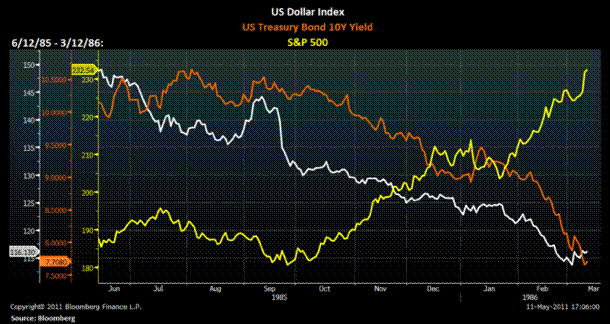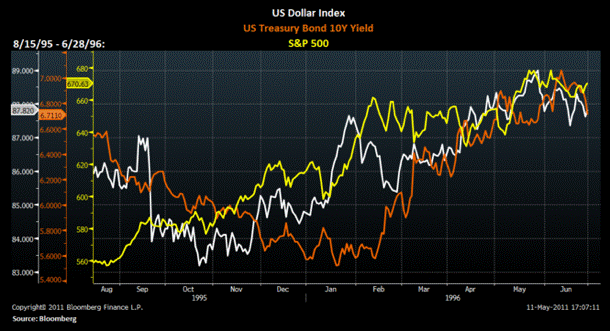美国债务上限调整之争将加剧市场震荡
|
周三美国众议院就是否上调美国举债上限进行投票表决(毫无意外,结果是响亮的“不”),我们认为应借此机会,对未来几个月可能的事态进展作一深入分析,即全球汇市、债市和股市的波动性可能加剧。即便6月份美联储(Federal Reserve)的美国国债购买计划(二次量化宽松政策)到期,华盛顿一些雄心勃勃的政客们所发出的奇谈怪论可能会继续左右宏观市场。 总之,虽然我们认同普遍的观点,相信美国举债上限最终会上调以避免美国政府一方有任何形式的债务违约行为,但我们也深知无论最终通过何种形式的方案都必将经历诸多风波和论战,而绝不会是“一帆风顺”。因此,我们已做好准备在未来几个月迎接更大的震荡。 |
With yesterday's House vote on raising the debt ceiling (unsurprisingly, a resounding 'no'), we thought we'd use this opportunity to equip you with an in-depth guide for navigating the next few months of what is likely to be heightened volatility for global currency, bond, and equity markets. Even as the Federal Reserve's bond purchasing program (QE2) expires in June, macro markets are likely to continue to gyrate on the whims and words of a few "inspired" politicians within our nation's capital. In short, while we accept the consensus belief that the debt ceiling will eventually be extended prior to any sort of default on the US government's obligations, we do believe the events and rhetoric leading up to the passage of any deal will be anything but "smooth sailing." As such, we're preparing for heighted volatility in the months ahead. |

|
无债可举:美国国会在1917年的Second Liberty Bond法案中首次设置了法定联邦举债上限,这是多方协商的结果,既解决了一战融资问题,又加强了对执行部门/执政党动财政权的限制。虽然联邦举债分为公众所持债务和政府内部债务,但几乎所有债务都受举债上限的制约。设置举债上限的初衷是为了创造机会,以便随时重新评估美国财政政策的方向。但是这一机制同样存在局限性,因为不上调债务上限的后果几乎总是比上调的后果更为严重,从决策角度看,上限机制相当缺乏实效。 美国财政部长蒂姆•盖特纳已表示,美国政府将于8月2日触及举债上限。之后,如果不上调举债上限或不通过某种形式的临时立法,使新债发行暂免于计入法定举债上限,美国政府将出现债务违约行为。盖特纳在致美国国会的信中明确指出,他认为任何形式的美国政府债务拖欠行为(不仅仅是美国国债的本金和利息偿付)都将损害美国的信誉。 虽然我们常常不能苟同盖特纳的观点,但在这一原则上我们确实有共同的立场,我们相信绝大多数美国人也都会认同。如果不及时上调举债上限,下列联邦政府债务的履行将首当其冲: • 美国的军饷和退休金; • 社保金和联邦医疗保险金; • 退伍军人津贴; • 联邦公务员工资和退休金; • 个人和企业退税; • 各州的失业金; • 应向国防供应商支付的款项; • 学生贷款支付; • 各州的医疗补助金;以及 • 联邦政府设施的日常运营费用。 仅这份清单所呈现的影响范围之广,就足以使我们确信美国国会最终将会永久性上调举债上限,或暂时搁置立法争议,至少临时性上调举债上限,以满足2011财年或日历年余下时间的借款需求。当然,正如人生中很多目的地一样,过程才是最重要的。有鉴于此,我们将对未来的道路作一展望。 政治攸关:1960年以来,美国国会已通过立法,共78次(永久性或临时性)上调举债上限或修改举债上限定义——其中49次是在共和党总统执政时期,29次是在民主党总统执政时期。因此,虽然表面上看触及债务上限似乎是件大事,但事实上,历史上上调债务上限的先例并不鲜见。 但从目前国会山反映出来的政治姿态和党派之争来看,我们预计这一次可能需要费些周折——特别是在博纳、瑞德等人物的领导下。可以预见,未来几个月铺天盖地的重磅观点、政治表态、边缘政策和重重顾虑将引发全球金融市场的震荡。正如我们在今年年初所指,第112届美国国会是对全球金融稳定的最大威胁之一。今夏,他们的所作所为将证实我们的判断。 今春早些时候美国政府差点关门一事告诉我们,为了推进其政治目标,任何一方都不惧将我们推到混乱的边缘。 总而言之,两党对于怎样才能于8月初前上调举债上限有很大的分歧,近期议员们的言论正体现了这一点。显然在上调举债上限的立法过程中将包含一定的财政改革(利多美元),但同样明确的是:a) 这不会让共和党人满意(利空美元),因为民主党人会坚持己见,推动边缘政策(证据之一就是共和党领袖已撤回了近期对保罗•瑞恩联邦医疗保险改革计划的支持);而且b):随着政治边缘政策把我们逐步推近最后期限,煽动恐慌的言论很可能将有所增加,导致全球金融市场恐慌情绪的蔓延。 因此,我们预计金融市场的震荡将全面加剧,因为各项资产类别间的关联风险已然升高。围绕美元的拉锯战是一大风险,需要妥善应对,而行动的时机尤其关键。 简言之,剧情将这样展开:共和党让步 = 美元下跌;民主党让步 = 美元上涨。未来几个月的棋局将变得更具挑战性。 历史性僵局 没错,我们以前也曾经处于这样的境地。下面将简要回顾一下历史上的举债上限僵局以及最终调高举债上限前的几个月里主要金融市场的表现。这绝非是试图预测未来几个月可能的事态发展;正如历史不会重演一样,任何两个债务周期都不会彼此雷同。在分析此次金融市场将如何反应时,下文所示图例仅作参考。 1985年:1985年9月,由于联邦负债已触及法定上限,美国财政部已无法再发行新的证券。因此,它不得不采取类似于前述策略的“临时性措施”。1985年11月14日债务上限临时上调,1985年12月12日债务上限从1.82万亿美元永久性上调至2.08万亿美元。此外,配套立法授权美国财政部可在未来陷入举债上限僵局时宣布进入“债券发行暂停期”。 |
Hitting the Ceiling:Congress created the statutory federal debt limit in the Second Liberty Bond Act of 1917 as a result of negotiations which resulted in securing financing for WWI and creating an additional check on the fiscal power of the executive branch/ruling party. While federal debt is appropriately divided between debt held by the public and intra-governmental debt, nearly all of it is subject to the limit. The powers that be at the time of creation appropriately intended the debt ceiling to be a reoccurring opportunity to reassess the direction of the U.S.'s fiscal policy. It is, however, not without limitations, as the current consequences of not increasing the debt ceiling almost always outweigh the current consequences of extending it, making it quite toothless from a policy-making point of view. Treasury Secretary Tim Geithner has said the government will reach its debt limit on August 2. After that, the U.S. government will begin to default on its obligations absent an increase in the debt ceiling or some form of temporary legislation exempting new issuance from being counted towards the statuary debt limit. What is being made clear by Geithner's letters to Congress is that he considers any failure to pay any of the U.S. government's obligations (not just interest payments and principal redemptions on Treasury securities) as a detriment to the full faith and credit backing America's handshake. While we don't often agree with the man, we do find common ground on this principle and we believe the vast majority of Americans would agree. Below is a list of federal government liabilities that would be directly impacted should the debt ceiling not get raised in time: • US military salaries and retirement benefits; • Social Security and Medicare benefits; • Veteran's benefits; • Federal civil service salaries and retirement benefits; • Individual and corporate tax refunds; • Unemployment benefits to States; • Defense vendor payments; • Student loan payments; • Medicaid payments to States; and • General operational expenses for federal government facilities. The sheer breadth of this list alone gives us conviction that Congress will ultimately enact a permanent increase in the debt ceiling or at least kick the can down the road by temporarily upping the limit to accommodate borrowing needs through the either the remainder of the fiscal or calendar year 2011. Of course, as with all of life's many destinations, it's the journey there that matters most. Given that, we offer a guide for the road ahead. Political Stakes: Since 1960, Congress has passed legislation that increased (permanently or temporarily) or revised the definition of the debt ceiling 78 times – 49 times under Republican presidents and 29 times under Democratic presidents. So while it may seem like reaching the debt ceiling is a big deal at face value, in reality, increasing the debt limit is quite a common occurrence. Judging by the political posturing and partisan rhetoric being thrown around Capitol Hill currently, however, we expect this round of piling debt upon debt to be anything but commonplace – especially with characters like Boehner and Reid leading the charge. The next few months will be full of enough headline-worthy news quotes, political posturing, brinksmanship, and enough fear mongering to rattle global financial markets. As we outlined at the beginning of the year, the 112th Congress is among the greatest risks to global financial stability. This summer we expect them to prove us right in spades. If we've learned anything from the near government shut down earlier this spring, it's that neither side is afraid to send us to the edge of chaos in order to advance their political agenda. All in all, the gaping divide between the two ideologies on what it would take to collectively lift the debt ceiling by early August is omnipresent in their recent commentary. While it's clear that some fiscal reform will be included in any legislation towards increasing the debt ceiling (U.S. dollar bullish), it's almost equally as clear that: a) it will fall short of current Republican demands (U.S. dollar bearish) because the Democrats are, on the margin, willing to stand their ground and engage in this game of political brinksmanship (evidenced by GOP leaders backing away from their recent support of Paul Ryan's Medicare reform plan); and b) as political brinksmanship inches us closer to the deadline, we are likely to see a measured increase in fear-mongering quotes that are likely to be the source of much consternation for global financial markets. As such, we anticipate a broad-based pickup in volatility, given the heighted correlation risk we've seen across all asset classes to date. This tug-of-war on the U.S. dollar is an acute risk that needs to be managed around, particularly from a timing perspective. In short, the playbook is as follows: Republican compromise = dollar down; Democrat compromise = Dollar up. Gaming policy is about to get a little more challenging in the coming months. Historic Impasses We've been here before, of course. Below we briefly touch upon prior debt limit impasses and how key financial markets fared in the months leading up to and just beyond the eventual increases. These are not at all an attempt to forecast what might happen in the coming months; like history itself, no two debt ceiling periods are alike. Rather, the illustrations below are merely points of reference for pondering how the markets will react this time around. 1985: In September of 1985, the Treasury Department became unable to issue new securities as a result of the statutory limit on federal debt being reached. As such, it was forced to take "extraordinary measures" consisting of and similar to the maneuvers listed in the section above. The debt limit was temporarily increased on November 14, 1985 and permanently increased on December 12,1985 from $1.82T to $2.08T. In addition, the accompanying legislation granted the Treasury Department authority to declare a "debt issuance suspension period" in future debt limit impasses. |

|
1995-96年:1995年11月15日,美国财政部首次宣布进入“债券发行暂停期”,凭借“临时性措施”挨到了下一年年初。随后,美国财政部通知国会手头没有足够的现金可支付1996年3月的社保金,对此国会作出的反应是临时上调举债上限,上调额度为社保金支付所需资金(290亿美元)。在临时性上调于3月15日即将失效前的一天,美国国会又批准延期两周至3月30日。而在3月30日的最后期限即将到来前一天,美国国会又通过了一项法案,将举债上限从4.9万亿美元永久性上调至5.5万亿美元。 |
1995-96:On November 15, 1995, the Treasury Department declared the first ever "debt issuance suspension period" and used "extraordinary measures" to finagle its way through the beginning of the next year. It subsequently notified Congress that it did not have enough cash on hand to pay the March 1996 Social Security benefits, at which point Congress responded by temporarily increasing the debt limit in an amount commensurate to the upcoming benefit distribution ($29B). Just one day before the March 15th deadline, Congress acted to extend the temporary increase by two weeks until March 30th. And just one day before that deadline, Congress passed legislation permanently increasing the debt limit to $5.5T from $4.9T. |

2002-03年:这两年间美国财政部不得不数次宣布进入“债券发行暂停期”(2002年4月4日- 2002年4月16日;2002年5月16日- 2002年6月28日;2003年2月20日- 2003年5月27日),并采取“临时性措施”,平滑现金流,以满足联邦政府履行债务所需。这段时期内,美国国会两次永久性上调举债上限;第一次是在2002年6月28日,从5.95万亿美元上调至6.4万亿美元,之后是在2003年5月27日,再次调高至7.38万亿美元。 2002-03:At several instances during this two year period, the Treasury Department had to declare "debt issuance suspension periods" (April 4, 2002-April 16, 2002; May 16, 2002-June 28, 2002; and February 20, 2003-May 27, 2003) and take "extraordinary measures" to smooth the timing of cash flows in order to meet the federal government's obligations. The debt limit was permanently increased twice during this legislative impasse; first on June 28, 2002 to $6.4T from $5.95T and subsequently on May 27, 2003 to $7.38T.













